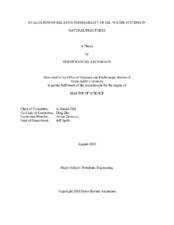| dc.description.abstract | This thesis is aimed to develop an understanding of relative permeability in fractures of oil-water systems. Currently, two-phase flow behavior across unpropped and propped fractures is not well known. As a result, reservoir modeling using computational simulation for the area involving fractures typically utilizes straight-line relative permeability and zero capillary pressure in fractures. Nonetheless, several experiments have shown that both viscous and capillary dominated flows can be predicted in naturally fractured reservoirs where non-straight-line relative permeability must be used to model such reservoirs correctly. The experimental analyses performed in this thesis were carried out using the outcrop core from the Eagle Ford shale formation. The outcrop Eagle Ford rock was cored into four 1.5" diameter by 6" cores and saw cut to generate a natural fracture on each core sample. The cores were then saturated in Eagle Ford formation oil at reservoir temperature for a minimum of 30 days before any experiments. The steady-state method was applied to measure the oil-water relative permeability. Eagle Ford formation oil and reconstituted brine with and without surfactants were used as the test fluids. The measurements were recorded at effective fracture closure stress and reservoir temperature. Also, real-time measurements of density, pressure, and flow rate will be logged throughout the entire duration of each test. Fluid saturations within the fracture were calculated using the mass continuity equation. Results from the experiment were analyzed using Darcy’s Law, and a visible relationship was found between saturation and relative permeability. The determined relative permeability curves closely follow the generalized Brooks-Corey relationship for oil-water systems. In comparison, there was a significant difference between the oil-water only systems and the oil-water surfactant systems in the relative permeability curves. Results from the experiments conducted indicate the potential for surfactant additives to significantly improve the relative permeability of oil by as much as 26%. Also, the results show the use of the straight-line relative permeability to predict oil recovery would result in a high percent error. | en |


